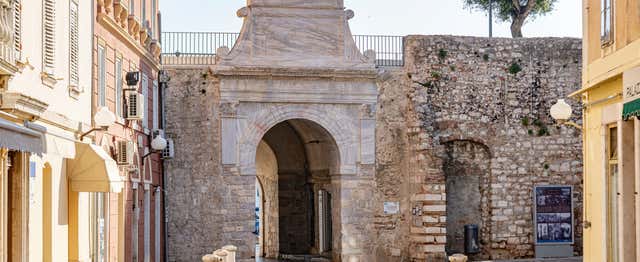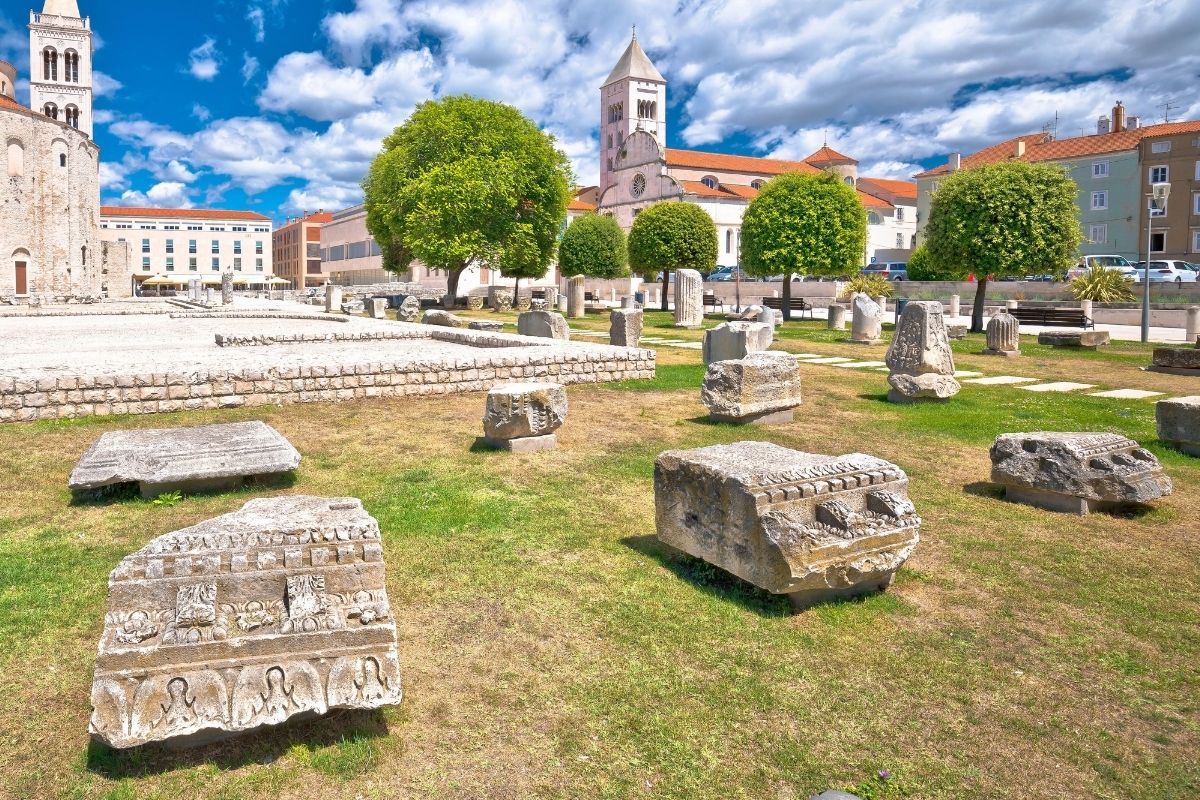Free Walking Tours in Zadar
The historic 3,000-year-old city of Zadar in Croatia should be on the top of your bucket list. This charming city, situated on Croatia’s Dalmatian coast, has plenty to offer with incredible architecture, terrific beaches, stunning islands, must-visit national parks and delectable cuisine.
The central location and modern facilities have made Zadar a popular gateway to Croatia. This little city has charm in spades, from the old town paved with gleaming white stone to the world-famous art installations at the harbor.
The historic 3,000-year-old city of Zadar in Croatia should be on the top of your bucket list. This charming city, situated on Croatia’s Dalmatian coast, has plenty to offer with incredible architecture, terrific beaches, stunning islands, must-visit national parks and delectable cuisine.
The central location and modern facilities have made Zadar a popular gateway to Croatia. This little city has charm in spades, from the old town paved with gleaming white stone to the world-famous art installations at the harbor.

(0/24) checking Musement...
The historic 3,000-year-old city of Zadar in Croatia should be on the top of your bucket list. This charming city, situated on Croatia’s Dalmatian coast, has plenty to offer with incredible architecture, terrific beaches, stunning islands, must-visit national parks and delectable cuisine.
The central location and modern facilities have made Zadar a popular gateway to Croatia. This little city has charm in spades, from the old town paved with gleaming white stone to the world-famous art installations at the harbor.
There’s no better way to explore the amazing attractions than with a free walking tour in Zadar.

Here's all you need to know about free walking tours, one of the most engaging sightseeing tours in Zadar.
How do free walking tours work?
Free walking tours in Zadar have become increasingly popular in recent years as they provide tourists with an affordable and authentic way of experiencing this incredible city.
Unlike walking tours, these tours are completely free to book and participate in, but it is encouraged that you tip your tour guide at the end of the tour. The amount you decide to tip is completely up to you.
How much should you tip?
When deciding how much to tip, think about the effort that your guide put into the tour and how much you enjoyed the tour overall.
Most tour participants tend to tip between €10 and €15 per person, but some people tip as much as €50 for outstanding tours.
What are the best free walking tours in Zadar?
There are a few options for free walking tours in Zadar, but the tours tend to visit the same attractions with a few variations. The tours are all led by professionals who are passionate about sharing their knowledge and expertise of their city.
Free spirit walking tour Zadar

This 1.5-hour-long walking tour offers an amazing introduction to Zadar. You will get an excellent overview of Zadar's history and culture and a unique glimpse into people’s everyday life. We recommend starting your visit to Zadar by booking this free walking tour as it’s the perfect opportunity to discover the city’s charms.
The tour hits all the must-see spots in the Old Town including the Roman Forum, Five Wells Square, St. Anastasia's Cathedral and lots more.
Delve into history at the first attraction and explore the Zadar Roman Forum. This ancient forum was once the center of public life. It was constructed between the 1st century B.C. and the 3rd century A.D. Now, among the ruins you can still see the intact Roman column, also known as a pillar of shame. People would be chained to the pillar, publicly mocked, humiliated, or even whipped.
Then visit the imposing Cathedral of St. Anastasia, an architectural masterpiece that's also the largest church in Dalmatia and the seat of the Archdiocese of Zadar. If the tour allows for it, you can try going up to the top of the bell tower to soak up the mesmerizing, panoramic views of the city below. The cathedral has undergone many renovations as it was damaged during various conflicts including World War 2, but this Romanesque-styled building is a stately beauty.
Another highlight is the Five Wells Square, which was built in 1574 and takes its name from the five wells that once gave Zadar its water supply. The square came about because of the Ottoman Empire's siege of Zadar. The Venetians built a large water cistern with five wells to ensure the people had water during the siege. The wells aren’t used anymore, but the square is a popular place for concerts and events.
The tour will include stops at the Sea Gate or St Chrysogonus' Gate. This historic archway serves as a significant reminder of Zadar's cultural heritage. It was built in 1573 when the Christian fleet defeated the Turks at Lepanto. The gate serves as a gateway to the city's historic center. You’ll also see the Land Gate, the final stop on the tour.
Zadar free walking tour

This 2.5-hour-long free walking tour is run by a tour guide who majored in Zadar’s history, so you’re certain to get all the historical details. The tour will visit all the major attractions from the Roman Forum to the Sea Organ, but you will also get additional church stops.
Get into the spirit of things with visits to numerous churches including the Church of St. Donatus – a symbol of the city. The church is an architectural example of the Carolingian period and it is considered the most significant of its kind in Europe. The cylindrical-shaped church is famous for its extraordinary acoustic features and is now used for musical performances, especially medieval Renaissance music.
The Roman Catholic Church of St. Chrysogonus is named after the patron saint of the city. The church features various archaic designs and statues of patron saints Chrysogonus, Anastasia, Simeon, and Zoilus. While it is no longer active, occasionally a few evening concerts are held there during the months of July and August.
Also on the itinerary is the Jelena Madio Park or the Queen Jelena Madijevka Park, a gorgeous public park that has numerous monuments. It’s named after Queen Jelena Madijevka, the wife of the famous Croatian King Dmitar Zvonimir. This picturesque park also has fascinating underground passages that were used to connect various parts of the city.
The People's Square is another popular stop. This lively square features many cafes and is a great spot to see some ancient buildings like the City Loggia, the City Guard, and the 16th-century clock tower. Spending some time here is a wonderful way to understand the local customs and traditions.
The final stop is at the Land Gate, one of the main entrances to the city. Built in 1543, it is one of the finest monuments of the Renaissance in Dalmatia. Take in the exquisite details and intricate carvings – especially the winged lion of St. Mark over the central arch.
Zadar free walking tour with local guide

Run by a licensed local tour guide with over 20 years of experience, this 2-hour long tour covers all of Zadar’s historical periods over the last 2,000 years This is a great crash course through Zadar and Croatian history. You’ll get to visit the city’s major attractions and a few more.
Check out Zadar’s city walls and defensive systems, which are a UNESCO World Heritage Site. Zadar was under Venetian rule and from the 15th to 17th century it was a naval and trading post. In order to protect the city, several defense mechanisms were built like the gates, bastions and fortified walls – all of which are still standing.
Discover the Church of Saint Simeon, which was built in the 17th-century and is home to the mummified body of St. Simeon, another of Zadar’s patron saints. His body is laid in a rectangular cedarwood sarcophagus that is over the church’s main altar. This ornately decorated final resting place is a masterpiece of medieval art and is under UNESCO protection.
Enjoy a touch of whimsy at the harbor with Croatian architect Nikola Bašić’s amazing Sea Organ. Carved into the seafront promenade, the Sea Organ, which is made up of 35 organ pipes, captures the movement of the waves and transforms it into music. Croatia’s Sea Organ was created to connect the locals back to the Adriatic Sea. The tone has been described as similar to when you blow on the top of a glass bottle. The more powerful the waves, the more lively and boisterous the music.
You’ll also experience another of Bašić’s creations, Greeting to the Sun. Zadar is already famous for having some of the most beautiful sunsets in the world, and the Greeting to the Sun art installation takes that experience further. This installation is made up of photo-sensitive glass plates that absorb daylight through solar cells and then emit it at night creating an unforgettable light show. Experience the magic of nature and science by listening to the Sea Organ and watching this impressive spectrum of colors.
In which languages is it operated?
Free walking tours in Zadar are most often conducted in English, however, some tours are also offered in Spanish, Italian, or Dutch. Double-check with the tour operator to book a tour in the language you prefer.
Where does it start?
Free walking tours tend to start at a popular tourist hotspot. This does vary according to the tour operator, however, common meet-up spots include the Roman Forum or Five Wells Square. You can find your meeting point on your tour booking form.
How long does it last?
Free walking tours in Zadar tend to run from 1.5 hours to 2.5 hours at the most. All tours visit many of the same attractions which are located quite close to each other.
Is it wheelchair friendly?
The tours are not wheelchair friendly as they are all listed as unsuitable for people with reduced mobility. However, you can also check with the tour operator before you book if arrangements can be made.
When is the best time to join a free walking tour in Zadar?
The best time for a free walking tour in Zadar is spring (April-May) and early autumn (September-October). During these months, the temperatures are mild and comfortable for walking, and you'll also miss the crowds of the peak summer season.
Should you book tickets online?
Booking free walking tours in Zadar online ensures your spot, as they are popular and get booked up very quickly. These tours also have limited spots available to ensure the quality of the tour— with some maximum capacities being limited to as few as 10 people.
Reserving your spot on a tour is completely free and can be done with a few simple clicks through the online booking platform. Arrive in Zadar with your tour already booked and make the most out of your time.

